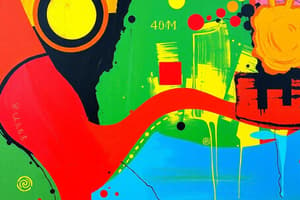Podcast
Questions and Answers
Which committee within the NCCA manages the award?
Which committee within the NCCA manages the award?
- National Heritage Committee
- Cultural Preservation Committee
- Artistic Creation Committee
- Gawad ng Bayan Committee (correct)
What is the purpose of the award managed by the National Commission for Culture and the Arts (NCCA)?
What is the purpose of the award managed by the National Commission for Culture and the Arts (NCCA)?
- To promote contemporary art in the Philippines
- To support and motivate artists to preserve their artistic heritage (correct)
- To encourage artists to move away from traditional practices
- To support foreign artists
What title do the recognized artists get according to the text?
What title do the recognized artists get according to the text?
- National Art Ambassador
- Cultural Heritage Icon
- Country's Intangible National Living Treasure (correct)
- Artistic Legacy Guardian
For how many years must a folk art tradition have been in existence and documented for a candidate to be considered as a National Living Treasure?
For how many years must a folk art tradition have been in existence and documented for a candidate to be considered as a National Living Treasure?
What is a key qualification required for a candidate to become a National Living Treasure?
What is a key qualification required for a candidate to become a National Living Treasure?
What is one of the responsibilities of a National Living Treasure according to the text?
What is one of the responsibilities of a National Living Treasure according to the text?
Who is mentioned as an awardee who preserved the Hanunuo Mangyan script and Ambahan poetry?
Who is mentioned as an awardee who preserved the Hanunuo Mangyan script and Ambahan poetry?
Which criteria must a candidate fulfill to have been consistently performed works of superior and distinctive quality?
Which criteria must a candidate fulfill to have been consistently performed works of superior and distinctive quality?
What is one of the requirements for a candidate to be an occupant of an indigenous/traditional cultural community anywhere in the Philippines?
What is one of the requirements for a candidate to be an occupant of an indigenous/traditional cultural community anywhere in the Philippines?
What regional background does Masino Intaray belong to according to the text?
What regional background does Masino Intaray belong to according to the text?
Study Notes
Pre-Colonial Art Forms in the Philippines
- Agung: An integral part of the Kulintang ensemble; played with a rubber-padded beater on both the boss and face of the gong.
- Banog-banog: A dance mimicking hunters protecting chickens from hawks.
- Blit B’laan: A courtship dance from the Bilaan of Davao del Sur, depicting bird mating rituals with females hiding and males chasing.
- Cañao: A ritual dance in the Cordilleras of Luzon, symbolizing triumph and abundant crops during native feasts.
- Gangsa: A traditional musical instrument used by the Bontoc tribes in the mountain regions of northern Philippines.
- Inamong: An ethnic dance by the Tigwahanon Manobos during harvest time, resembling the flirtation of monkeys.
Musical Instruments
- Kadal Iwas: Nose flute of the Apayao.
- Bansik: Bamboo flute of the Negrito.
- Kaleleng: Long bamboo flute of the Bontoc.
- Bulungudyong: Vertical flute of the B'laan community.
- Kalaleng: Bamboo flute of the Tinggian.
- Lantoy: Nose flute of the Mangyan.
- Palandag (Palendag): Lip-valley flute of the Bagobo.
- Paldong and Tongali: Lip valley flutes from Kalinga.
- Pulalo: Lip valley flute of the Mansaka.
- Sahunay: Pipe made with reed, similar to a clarinet, used by the Tausog.
Chordophones
- Instruments producing sound via vibrating strings stretched between points, showcasing creativity and ingenuity.
- Faglong: Two-stringed lute of the B'laan.
- Kolitong: Bamboo guitar of Kalingga.
- Kudlong: Two-stringed boat lute of the Bagobo.
- Kudyapi: Two-stringed boat lute of the Maranao.
- Kulit-en: Guitar of the Tinggian.
- Pas-ing: Guitar from the Igorot community.
- Serongagandi: Decorated bamboo tube of the Maranao.
- Saludoy: Bamboo guitar of the T’boli.
Idiophones
- Instruments that create sound through vibration without strings or membranes, reflecting artistic creativity.
Common Handicraft Materials
- Filipino families utilize handicrafts such as baskets, brooms, and furniture, showcasing local craftsmanship and creativity.
- Typical materials include:
- Abaca: Durable, tree-like herb used for dyeing.
- Bamboo: Strong material for furniture and baskets.
- Buri: Palm used for various fibers, especially for weaving hats and novelty items.
- Caragumoy: Green-grey fibers used for making hats and mats.
- Coconut: Versatile palm producing crafts from baskets to lamp shades.
- Kalas: By-product of buri, creating rustic woven patterns.
- Leather: Tanned animal skins used for various handicrafts.
- Pandan-Dagat: Screw pine, found along coastal areas.
- Rattan: Flexible material for manufacturing furniture.
- Seagrass: Grass from shallow waters, used in weaving handicrafts.
Regional Handicrafts
- Jewelry is predominantly crafted in Central Luzon, especially in Bulacan, highlighting the region's artisanal skills.
Studying That Suits You
Use AI to generate personalized quizzes and flashcards to suit your learning preferences.
Description
This quiz covers pre-colonial art forms in the Philippines, focusing on the Agung musical instrument and cultural dances like Banog-banog and BlitB'laan. Test your knowledge on these traditional art expressions.




